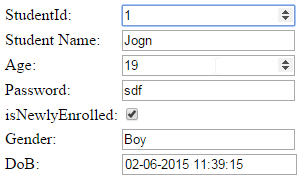Asp.Net MVC - Htmlhelper 总结
Asp.Net MVC - Htmlhelper 总结
HtmlHelper是一个返回Html字符串的方法。返回的字符串可以是任意类型。例如你可以使用HtmlHelper方法返回一个标准的html标签<input> <button> <img>等等。
你也可以自定义HtmlHelper方法,返回一些复杂的html,来展示数据。
Razor编码
首先需要认识了解一下Razor的编码
在Razor中返回类型为IHtmlString的都会被编码成html,其他都是string字符串。
//Controller
string msgStr = "this is an html element: <input>";
ViewBag.Msg = msgStr;
ViewBag.Msg1 = new MvcHtmlString(msgStr);Razor:

- Html.Encode()返回类型为string。
- Html.Raw()返回类型为IHtmlString。
- MvcHtmlString.Create返回类型为继承自IHtmlString的MvcHtmlStrin。
- ViewBag是动态类型,Controller里ViewBag是什么类型,在Razor对应就是何种类型。
简单总结下HtmlHelper的几种扩展方法。
1. 视图中的Helper方法
在razor页面中使用@helper创建一个自定义的方法,该方法只能用在当前razor页面中。
@helper ListingItems(string[] items)
{
<ol>
@foreach (string item in items)
{
<li>@item</li>
}
</ol>
}
<h3>Programming Languages:</h3>
@ListingItems(new string[] { "C", "C++", "C#" })
<h3>Book List:</h3>
@ListingItems(new string[] { "How to C", "how to C++", "how to C#" })2. 常见的HtmlHelper扩展方法
该类型的Helper可以生成多种Hmtl控件如:text boxe checkbox等待。
首先声明一个Model
[DisplayName("学生")]
public class Student
{
public int StudentId { get; set; }
[Display(Name="姓名")]
public string StudentName { get; set; }
public int Age { get; set; }
public bool isNewlyEnrolled { get; set; }
public string Password { get; set; }
[DisplayFormat(DataFormatString = "{0:yyyy年MM月dd日}")]
[Display(Name ="生日")]
public DateTime BirthDay{get;set;}
}
1.1 TextBox
Razor:
@model Student
//传递一个null值
@Html.TextBox("StudentName", null, new { @class = "form-control" })
//使用一个字符串,作为值
@Html.TextBox("StudentName", "this is value", new { @class = "form-control" }
//Controller:ViewBag.StudentName="Janes";
//使用ViewBag获取数据
@Html.TextBox("StudentName", (string)ViewBag.StudentName, new { @class = "form-control" })
//Controller: StudentName="Janes";
//使用Model获取数据
@Html.TextBox("StudentName", Model.StudentName, new { @class = "form-control" }) Html:
<input class="form-control" id="StudentName" name="StudentName" type="text" value="" />
<input class="form-control" id="StudentName" name="StudentName" type="text" value="this is value" />
<input class="form-control" id="StudentName" name="StudentName" type="text" value="Janes" />
<input class="form-control" id="StudentName" name="StudentName" type="text" value="Janes" />1.2 TextBoxFor
Razor:
@model Student
//Controller: StudentName="Janes";
@Html.TextBoxFor(m => m.StudentName, new { @class = "form-control" })
Html:
<input class="form-control" id="StudentName" name="StudentName" type="text" value="Janes" />TextBox和TextBoxFor的区别:
-
@Html.TextBox是一个弱类型,@Html.TextBoxFor()是个强类型。
-
@Html.TextBox参数是一个字符串,@Html.TextBoxFor参数是一个lambda表达式。
-
@Html.TextBox如果属性拼写错误在编译的时候不会报错,只能在运行才会报错。
-
@Html.TextBoxFor在编译的时候会提示错误。
2.1 TextArea
TextArea()方法是一种若类型的方法,name参数是一个字符串。name参数可以是Model的属性名。它将指定的属性与textarea绑定在一起。因此,它会自动显示文本区域中的Model的属性值,反之亦然。
Razor:
@Html.TextArea("Textarea1", "val", 5, 15, new { @class = "form-control" })Html:
<textarea class="form-control" cols="15" id="Textarea1" name="Textarea1" rows="5">val</textarea>2.2 TextAreaFor
TextAreaFor方法是一种强类型的扩展方法。它为使用lambda表达式指定的Model中的属性生成了一个多行的元素。TextAreaFor方法将指定的Model属性绑定到textarea元素。因此,它会自动显示文本区域中的Model属性值,反之亦然。
Razor:
@model Student
@Html.TextAreaFor(m => m.Description, new { @class = "form-control" }) Html:
<textarea class="form-control" cols="20" id="Description" name="Description" rows="2"></textarea>3.1 Password
Razor:
@Html.Password("OnlinePassword")Html:
<input id="OnlinePassword" name="OnlinePassword" type="password" value="" />3.2 PasswordFor
Razor:
@model Student
//Controller: Password="mypassword";
@Html.PasswordFor(m => m.Password)Html:
<input id="Password" name="Password" type="password" value="mypassword" />4.1 Hidden
生成一个包含指定名称、值和html属性的输入隐藏字段元素。
Razor:
@model Student
//Controller:StudentId=1;
@Html.Hidden("StudentId")Html:
<input id="StudentId" name="StudentId" type="hidden" value="1" />4.2 HiddenFor
是一种强类型扩展方法。它为使用lambda表达式指定的Model属性生成一个隐藏的输入元素。Hiddenfor方法将一个指定的Model属性绑定到一个指定的对象属性。因此,它自动将Model属性的值设置为隐藏字段,反之亦然。
Razor:
@model Student
@Html.HiddenFor(m => m.StudentId)Html:
<input data-val="true" id="StudentId" name="StudentId" type="hidden" value="1" />5.1 CheckBox
Razor:
@Html.CheckBox("isNewlyEnrolled", true)Html:
<input checked="checked" id="isNewlyEnrolled" name="isNewlyEnrolled" type="checkbox" value="true" />5.2 CheckBoxFor
Razor:
@model Student
@Html.CheckBoxFor(m => m.isNewlyEnrolled)Html:
<input data-val="true" data-val-required="The isNewlyEnrolled field is required." id="isNewlyEnrolled" name="isNewlyEnrolled" type="checkbox" value="true" />
<input name="isNewlyEnrolled" type="hidden" value="false" />6.1 RadioButton
Razor:
Male: @Html.RadioButton("Gender","Male")
Female: @Html.RadioButton("Gender","Female") Html:
Male: <input checked="checked" id="Gender" name="Gender" type="radio" value="Male" />
Female: <input id="Gender" name="Gender" type="radio" value="Female" />6.2 RadioButtonFor
Razor:
@model Student
@Html.RadioButtonFor(m => m.Gender,"Male")
@Html.RadioButtonFor(m => m.Gender,"Female")Html:
<input checked="checked" id="Gender" name="Gender" type="radio" value="Male" />
<input id="Gender" name="Gender" type="radio" value="Female" />7.1 DropDownList
Razor:
@model Student
@Html.DropDownList("StudentGender", new SelectList(Enum.GetValues(typeof(Gender))), "Select Gender", new { @class = "form-control" })Html:
<select class="form-control" id="StudentGender" name="StudentGender">
<option>Select Gender</option>
<option>Male</option>
<option>Female</option>
</select>7.2 DropDownListFor
Razor:
@Html.DropDownListFor(m => m.StudentGender, new SelectList(Enum.GetValues(typeof(Gender))), "Select Gender")
Html:
<select class="form-control" id="StudentGender" name="StudentGender">
<option>Select Gender</option>
<option>Male</option>
<option>Female</option>
</select>8.1 ListBox
Razor:
@Html.ListBox(“ListBox1”, new MultiSelectList(new [] {"Cricket", "Chess"}))html:
<select id="ListBox1" multiple="multiple" name="ListBox1"> <option>Cricket</option> <option>Chess</option> </select>### 9.1 Display
Razor:
@model Student
@Html.Display("StudentName")
Html:
Steve9.2 DisplayFor
Raozr:
@model Student
@Html.DisplayFor(m => m.StudentName)Html:
Steve10.1 Label
Razor:
@Html.Label("StudentName")
@Html.Label("StudentName","Student-Name")Html:
<label for="StudentName">姓名</label>
<label for="StudentName">Student-Name</label>10.2 LabelFor
Razor:
@model Student
@Html.LabelFor(m => m.StudentName)Html:
<label for="StudentName">姓名</label>11.1 Editor
该扩展方法是一种基于数据类型生成html输入元素的方法。Editor()或EditorFor()扩展方法基于Model对象的属性的数据类型生成html标签。
| 数据类型 | Html标签 |
|---|---|
| string | <input type="text" > |
| int | <input type="number" > |
| decimal, float | <input type="text" > |
| boolean | <input type="checkbox" > |
| Enum | <input type="text" > |
| DateTime | <input type="datetime" > |
Razor:
StudentId: @Html.Editor("StudentId")
Student Name: @Html.Editor("StudentName")
Age: @Html.Editor("Age")
Password: @Html.Editor("Password")
isNewlyEnrolled: @Html.Editor("isNewlyEnrolled")
Gender: @Html.Editor("Gender")
DoB: @Html.Editor("DoB")Html:
11.2EditorFof
Razor:
StudentId: @Html.EditorFor(m => m.StudentId)
Student Name: @Html.EditorFor(m => m.StudentName)
Age: @Html.EditorFor(m => m.Age)
Password: @Html.EditorFor(m => m.Password)
isNewlyEnrolled: @Html.EditorFor(m => m.isNewlyEnrolled)
Gender: @Html.EditorFor(m => m.Gender)
DoB: @Html.EditorFor(m => m.DoB)
Html:
---
12 Form
Razor:
@using (Html.BeginForm("ActionName", "ControllerName", FormMethod.Post, new { @class = "form" }))
{
}Html:
<form action="/ControllerName/ActionName" class="form" method="post">
</form>13.1 Html.Action() 执行一个Action,并返回html字符串。
13.2 Html.ActionLink() 生成一个超链接。
如:
Html.ActionLink("link text", "someaction", "somecontroller", new { id = "123" }, null)
返回:
<a href="/somecontroller/someaction/123">link text</a>
13.3 Url.Action() 返回一个Action的链接地址
如:
Url.Action("someaction", "somecontroller", new { id = "123" })
返回:
/somecontroller/someaction/123
自定义Helper扩展方法
您还可以通过在HtmlHelper类上创建扩展方法或在类中创建静态方法来创建自定义Helper方法。
public static class CustomHelpers
{
//Submit Button Helper
public static MvcHtmlString SubmitButton(this HtmlHelper helper, string
buttonText)
{
string str = "<input type=\"submit\" value=\"" + buttonText + "\" />";
return new MvcHtmlString(str);
}
//Readonly Strongly-Typed TextBox Helper
public static MvcHtmlString TextBoxFor<TModel, TValue>(this
HtmlHelper<TModel> htmlHelper, Expression<Func<TModel, TValue>>
expression, bool isReadonly)
{
MvcHtmlString html = default(MvcHtmlString);
if (isReadonly)
{
html = System.Web.Mvc.Html.InputExtensions.TextBoxFor(htmlHelper,
expression, new { @class = "readOnly",
@readonly = "read-only" });
}
else
{
html = System.Web.Mvc.Html.InputExtensions.TextBoxFor(htmlHelper,
expression);
}
return html;
}
}以上就是HtmlHelper的一些常用扩展方法。


【推荐】还在用 ECharts 开发大屏?试试这款永久免费的开源 BI 工具!
【推荐】国内首个AI IDE,深度理解中文开发场景,立即下载体验Trae
【推荐】编程新体验,更懂你的AI,立即体验豆包MarsCode编程助手
【推荐】轻量又高性能的 SSH 工具 IShell:AI 加持,快人一步